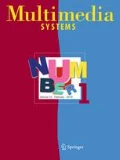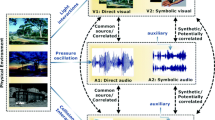Abstract
The ability of technology to transmit multi-media is very dependent on compression techniques. In particular lossy compression has been used in image compression (jpeg) audio compression (mp3) and video compression (mpg) to allow the transmission of audio and video over broadband network connections. Recently the sense of touch or haptics is becoming more important with its addition in computer games or in cruder applications such as vibrations in a cell phone. As haptic technology improves the ability to transmit compressed force sensations becomes more critical. Most lossy audio and visual compression techniques rely on the lack of sensitivity in humans to pick up detailed information in certain scenarios. Similarly limitations in the sensitivity of human touch could be exploited to create haptic models with much less detail and thus requiring smaller bandwidth. The focus of this paper is on the force thresholds of the human haptic system that can be used in a psychophysically motivated lossy haptic (force) compression technique. Most of the research in this field has measured the just noticeable difference (JND) of the human haptic system with a human user in static interaction with a stationary rigid object. In this paper our focus involves cases where the human user or the object are in relative motion. An example of such an application would be the haptic rendering of the user’s hand in contact with of a high-viscous material or interacting with a highly deformable object. Thus an approach is presented to measure the force threshold based on the velocity of the user’s hand motion. Two experiments are conducted to detect the absolute force threshold (AFT) of the human haptic system using methodologies from the field of psychophysics. The AFTs are detected for three different ranges of velocity of the user’s hand motion. This study implies that when a user’s hand is in motion fewer haptic details are required to be stored calculated or transmitted. Finally the implications of this study on a more complete future study will be discussed.
Similar content being viewed by others
References
Miano J. (1999). Compressed Image File Formats: JPEG PNG GIF XBM BMP. ACM Press, New York
Brandenburg K.: MP3 and ACC explained. In: Proceedings of the AES 17th International Conference on High Quality Audio Coding Florence Italy September 1999
Gersho A.: Advances in speech and audio compression 900-918 June (1994)
Bhaskaran V., Konstantinides K.: Image and Video Compression Standards Algorithms and Architectures 2nd edn. Kluwer, USA (1999)
Wood J. Magennis M. Arias E.F.C. Gutierrez T. Graupp H. Bergamasco M.: The Design and Evaluation of a Computer Game for the Blind in the GRAB Haptic Audio Virtual Environment. In: Proc. of Eurohpatics (2003)
Marti S. Schmandt C.: Giving the caller the finger: collaborative responsibility for cellphone interruptions. In: Conference on Human Factors in Computing Systems archive CHI ’05 extended abstracts on Human factors in computing systems pp. 1633–1636 Portland OR USA (2005)
Hinterseer P. Steinbach E.: Psychophysically Motivated Compression of Haptic Data. In: Proceedings of the Joint International COE/HAM—SFB453 Workshop on Human Adaptive Mechatronics and High Fidelity Telepresence October (2005)
Wang D. Tuer K. Rossi M. Joseph S.: Haptic Overlay Device for Flat Panel Touch Displays. HAPTICS p. 290 (2004)
Hinterseer P. Steinbach E.: A Phychophysically Motivated Compression Approach for 3D Haptic Data. In: 14th Symposium on Haptic Interfaces for Virtual Environment and Teleoperator Systems pp. 35–41 March (2006)
Hinterseer P. Steinbach E. Chaudhuri S.: Perception-Based Compression of haptic Data Streams Using Kalman Filters. IEEE Int. Conf. Acoust. Speech Signal Process. pV–473–V–476 (2006)
Hinterseer P. Steinbach E. Hirche S. Buss M.: A novel psychophysically motivated transmission approach for haptic data streams in telepresence and teleaction systems. In: Proceedings of the IEEE International Conference on Acoustics Speech and Signal Pro-cessing pp. 1097–1100. Philadelphia, PA, USA March (2005)
Lederman S.J., Klatzky R.L., Hamilton C.L. and Ramsay G.I. (1999). Perceiving roughness via a rigid probe: psychophysical effects of exploration speed and mode of touch. Haptics-e (Electron. J. Haptics Res.) 1(1): 1–20
Jandura L. Srinivasan M.A.: Experiments on Human Performance in Torque Discrimination and Control. In: Proc. of the ASME Dynamic Systems and Control Division, vol. 55-1 pp. 369–375 (1994)
McLaughlin M.L., Hespanha J.P. and Sukhatme G.S. (2002). Touch in virtual environments: haptics and the design of interactive systems. Prentice Hall, Englewood Eliffs
Shahabi C. Ortega A. Kolahdouzan M.R.: A Comparison of Different Haptic Compression Techniques. Multimedia and Expo, (2002)
Kuschel M. Kremer P. Hirche S. Buss M.: Lossy data reduction methods for haptic telepresence systems. In: Proceedings 2006 IEEE International Conference on Robotics and Automation ICRA 2006, Las Vegas, May (2006)
Hinterseer P. Steinbach E. Chaudhuri S.: Model-based Data Compression for 3D Virtual Haptic Teleinteraction. In: IEEE International Conference on Consumer Electronics, ICCE 2006 January (2006)
Gescheider G.A.: Psychophysics: The Fundamentals Lawrence Erlbaum Associates, 3rd ed. (1997)
Jones L.A. (1989). Matching forces: constant errors and differential thresholds. Perception 18(5): 681–687
Pang X., Tan H.Z. and Durlach N. (1991). Manual discrimination of force using active finger motion. Percept. Psychophy. 49(6): 531–540
Allin S. Matsuoka Y. Klatzky R.L.: Measuring Just Noticeable Differences for Haptic Force Feedback: Implications for Rehabilitation. In: Symposium on Haptic Interfaces for Virtual Environment and Teleoperator Systems, pp. 299–302 (2002)
Doerrer C. Werthschutzky R.: Simulating Push-Buttons Using a Haptic Display: Requirements on Force Resolution and Force-Displacement Curve. In: Wall S.A., et al. vol. 114, pp. 41–46 (2002)
Wu (Mary) M. Abbott J.J. Okamura A.M.: Effects of Velocity on Human Force Control. WHC, pp. 73–79 (2005)
Sensable Technologies Inc. http://www.sensable.com
Author information
Authors and Affiliations
Corresponding author
Rights and permissions
About this article
Cite this article
Zadeh, M.H., Wang, D. & Kubica, E. Perception-based lossy haptic compression considerations for velocity-based interactions. Multimedia Systems 13, 275–282 (2008). https://doi.org/10.1007/s00530-007-0106-9
Published:
Issue Date:
DOI: https://doi.org/10.1007/s00530-007-0106-9




